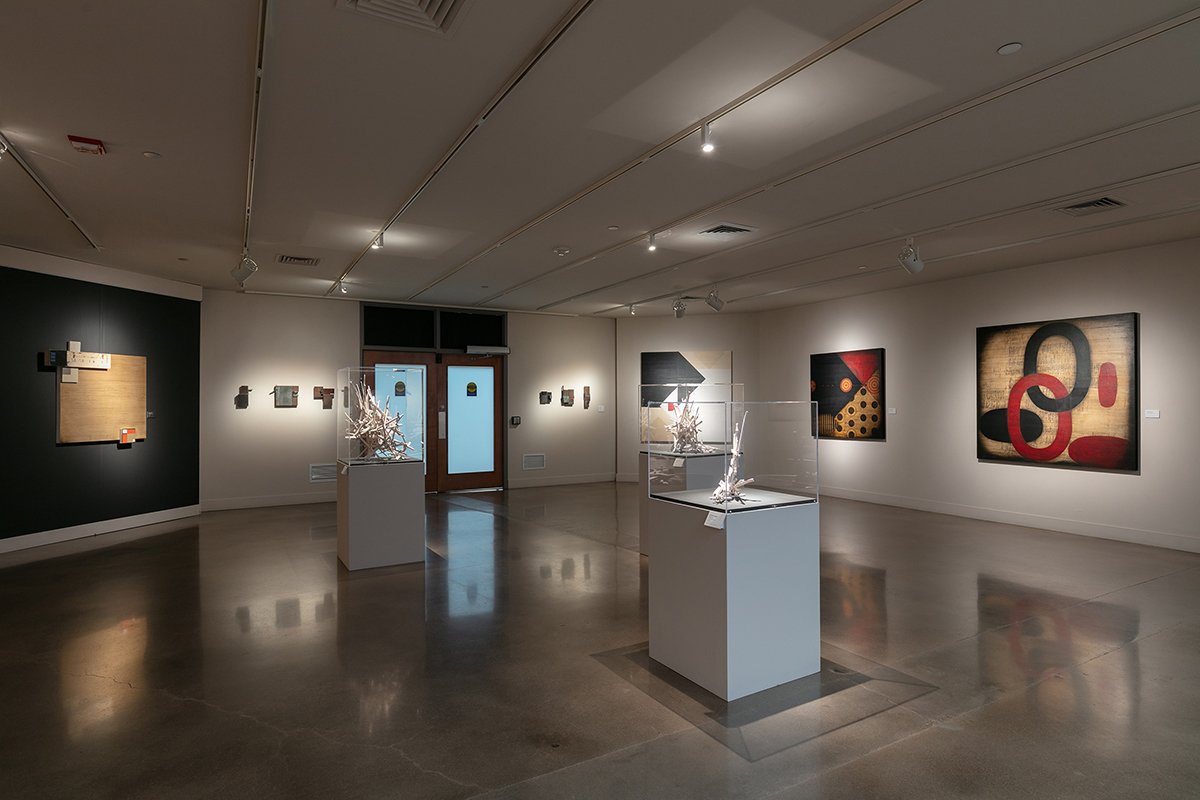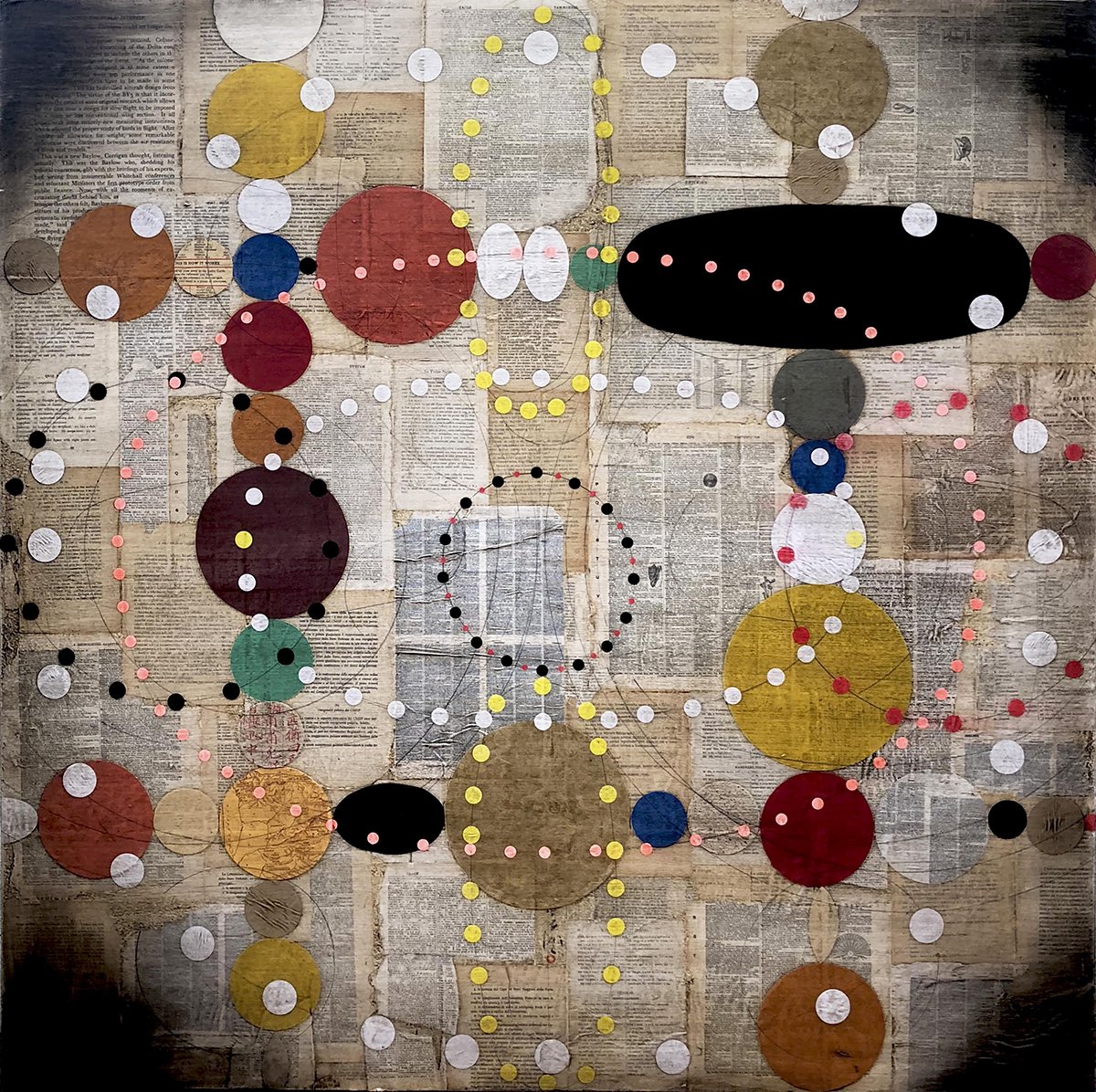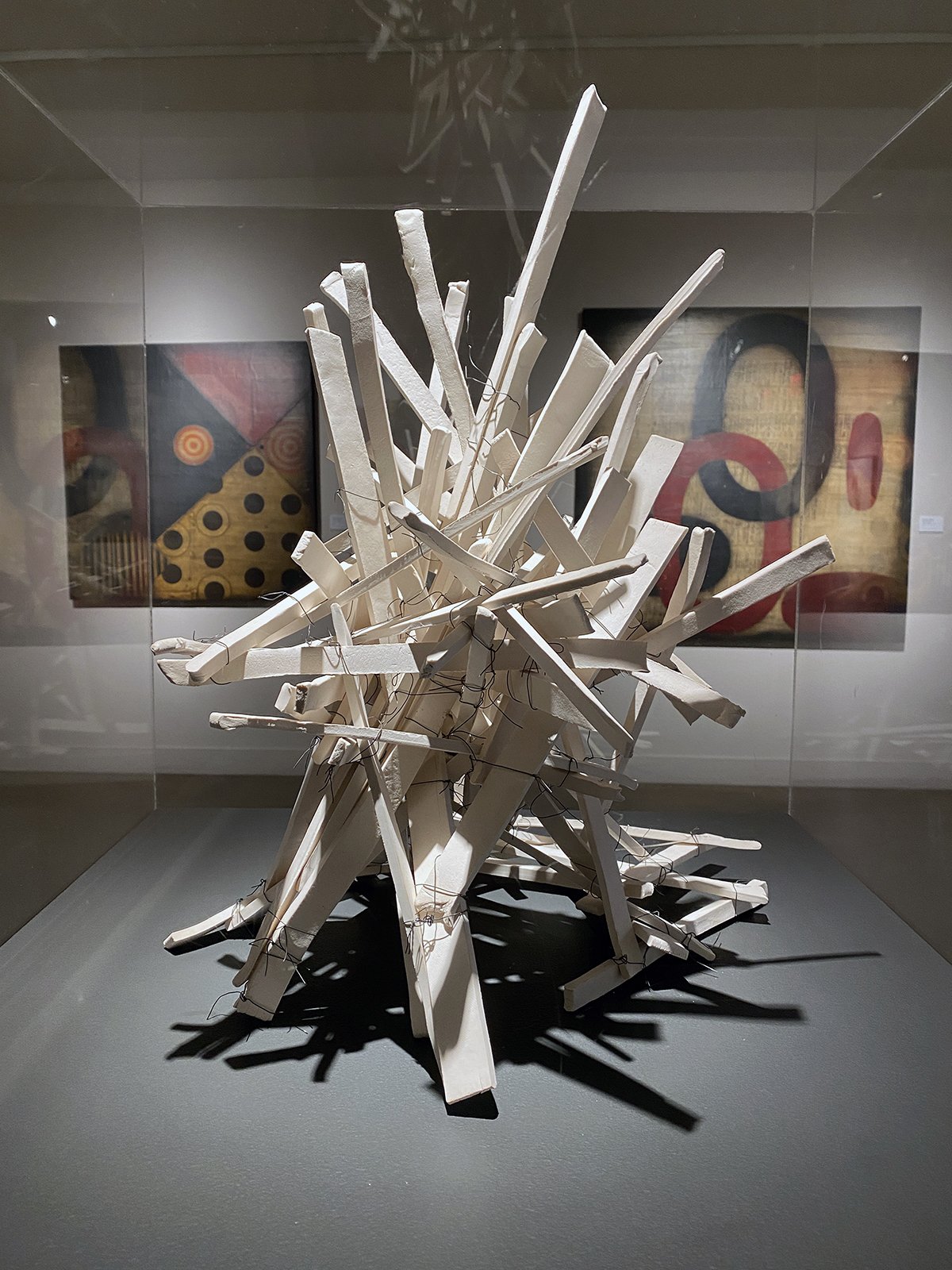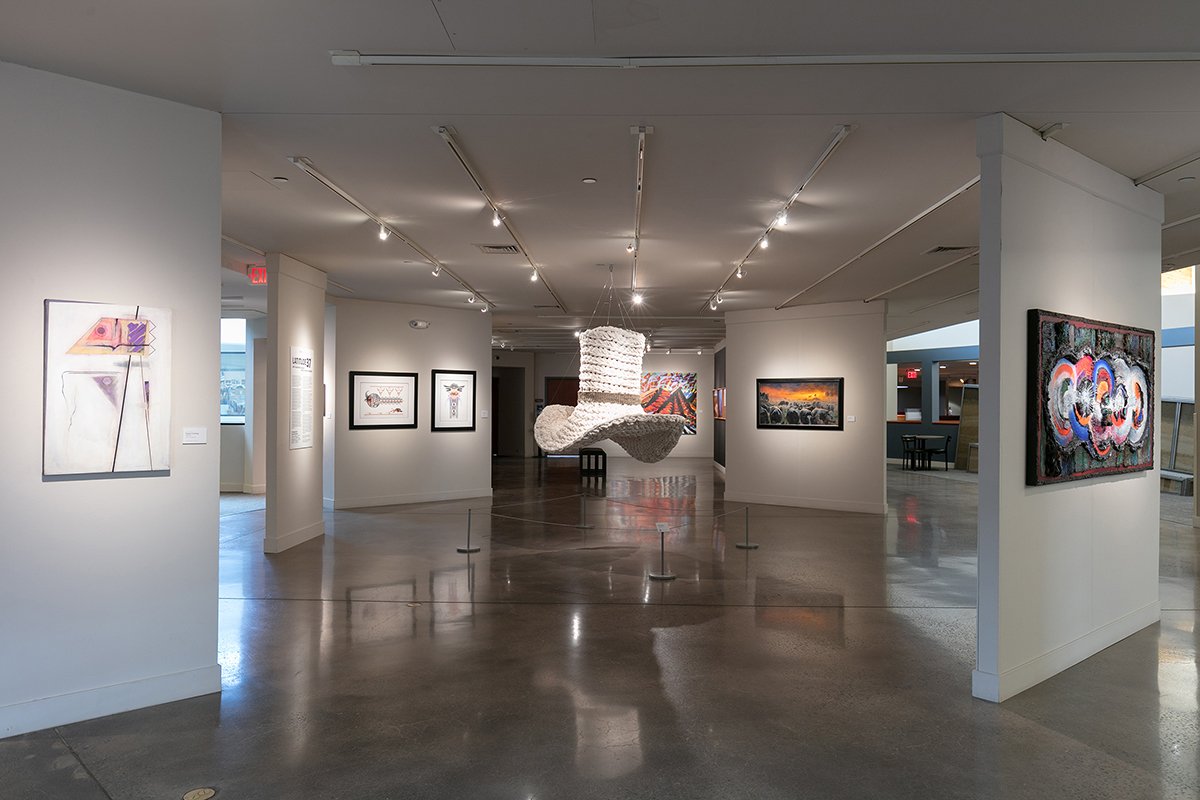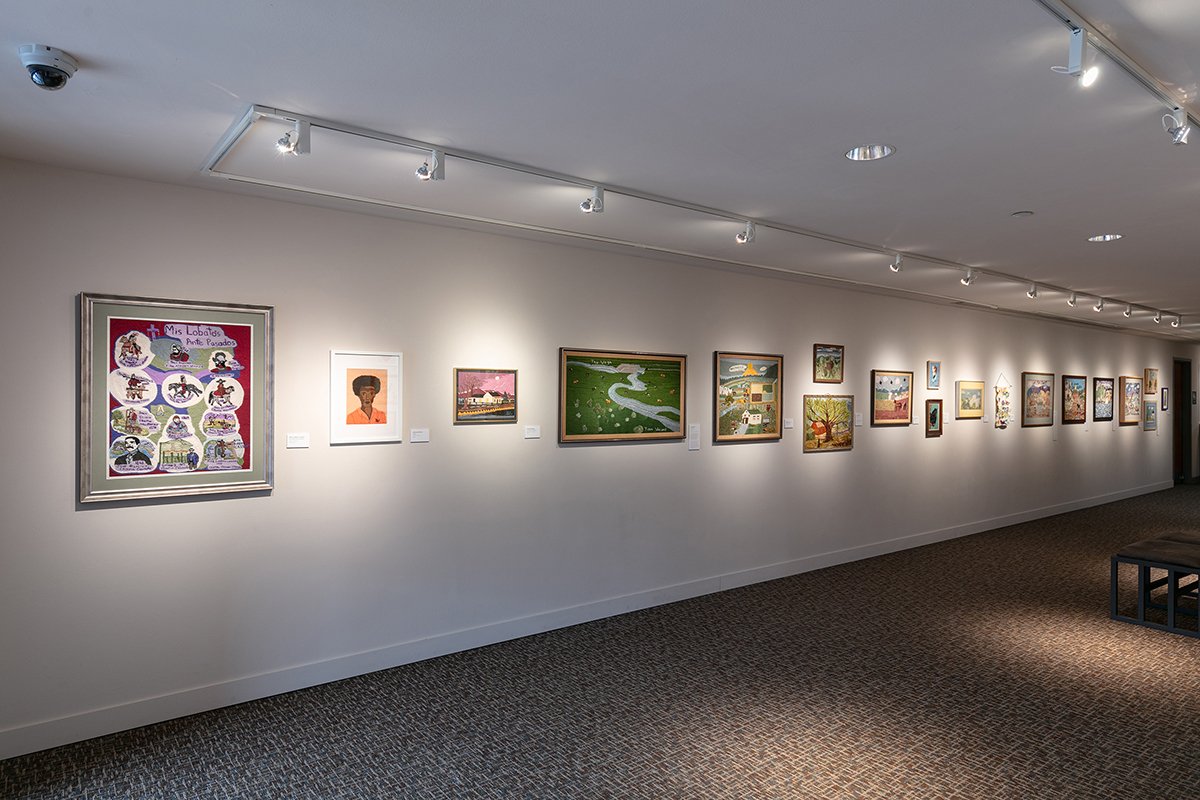A Mi Manera | Latitude 37°: Art of Southern Colorado | Colcha Embroidery of the San Luis Valley
Emilio Lobato: A Mi Manera | Latitude 37°: Art of Southern Colorado | Colcha Embroidery of the San Luis Valley
Arvada Center for the Arts and Humanities
6901 Wadsworth Boulevard, Arvada, CO 80003
September 14-November 12, 2023
Admission: Free
Review by Danielle Cunningham
The Arvada Center’s three newest exhibitions explore the history, traditions, and aesthetic of the San Luis Valley, affectionately known as the Valley. In the Main Gallery, Emilio Lobato’s retrospective A Mi Manera: A 40-Year Survey encompasses the Valley native’s innovation and numerous stylistic changes. Meanwhile, two group exhibitions, Latitude 37°: Art of Southern Colorado and Colcha Embroidery of the San Luis Valley, embody the region’s influence and relationship to colonialism and hybridity, respectively.
An installation view of Emilio Lobato’s exhibition A Mi Manera: A 40-Year Survey at the Arvada Center for the Arts and Humanities. Image by Wes Magyar, courtesy of the Arvada Center.
Lobato’s exhibition is organized by style rather than chronology, highlighting his dedication to his intuition and independence from art world trends. From earthy, monumental abstract paintings and collages to delicate porcelain sculptures and minimalist assemblages, Lobato’s artistic flexibility and endurance are major themes throughout his work. Perhaps because he has trusted his instincts, Lobato’s creative practice has remained interesting to viewers, never becoming stale or complacent.
Four works by Emilio Lobato: (from left to right) Snowflake, 2023, rubber on panel; Europa, Adrastea, and Io, all 2022, rubber and nails. Image by Wes Magyar, courtesy of the Arvada Center.
Despite differences in style, medium, and materials, there are continuities in the work, including a neutral and solemn color palette, an obvious interest in geometry, and a commitment to exploring the boundaries of abstraction. Lobato especially favors circles, which are present in nearly every work and range in color, size, and alternating uses as both prominent fixtures and background material. Though most of the pieces are dark, and covered in plenty of black, red, beige, and tan, several works are more playful and feature smaller, colorful patterns and shapes.
Emilio Lobato, Años Levianos (Light Years), 2018, oil and collage on panel. Image courtesy of William Havu Gallery.
One of these works, Años Levianos (Light Years) from 2018, is a large oil painting with collage on panel. Over a background of yellowed book pages that are densely covered in text, small circles and oblong shapes form a grid, overlaid by additional shapes arranged into circular and spherical patterns. The result is a tremendous feeling of energy that seems to move around the canvas and yet, the work is meditative, provoking internal contemplation. Lobato notes his intention for work such as this, stating, “I wanted to create a language that would describe what I was feeling and how do you do that with shapes and form and composition…?” [1]
Emilio Lobato, Io, 2022, rubber and nails. Image courtesy of the Arvada Center.
Like his abstract work, the artist’s assemblages also indicate his interest in geometry, but rather than using paint, Lobato employs rubber, metal, rulers, and even antique printing blocks. Io, from 2022, is futuristic-looking in its simple construction and mostly black façade—an aspect that is compounded in that its title likely refers to one of Jupiter’s moons.
The work is small and requires a moment of study to realize it is made entirely from rubber, save several nails. Once again showcasing Lobato’s love of circles, Io features a black background with two layered disks, one folded imprecisely to the left and fastened by a black strap, revealing a second circle. This one is bound by an orange strap, which is the only pop of color in this assemblage. The presence of folded and bound materials creates a striking tension for such a small object, as if each circle is fighting the other for visibility and prominence.
Emilio Lobato, Make Do, 2021, porcelain and wire. Image courtesy of the Arvada Center.
One body of work is an outlier in the exhibition due to its composition, stark appearance, and materials; it reminds viewers that Lobato knows how to generate curiosity. Made of porcelain and wire, Make Do, Temporal, and Mother of Invention, all from 2021, resemble bundles of sun-bleached sticks or even bones, calling attention to the artist’s rural upbringing near the San Juan Mountains. Lobato’s decision to present porcelain in its natural hue also calls to mind the nearby Great Sand Dunes, which Lobato would’ve undoubtedly seen or perhaps visited during his time in the Valley. Unlike other works in the exhibition, these objects seem to outwardly reference the Valley’s landscape, and what can be a starkly beautiful, sometimes harsh, and often isolating environment.
An installation view of Latitude 37º at the Arvada Center for the Arts and Humanities. Image by Wes Magyar, courtesy of the Arvada Center.
Annette Troncoso, Back in the Fields, 2021, oil on canvas. Image by DARIA.
Despite its occasionally inclement weather, or perhaps because of it, the Valley is home to many artist communities showcased in Latitude 37°, in which the artists’ precise latitudinal coordinates are documented on their artwork labels. Artists like Annette Troncoso speak to the importance of farming in the region with Back in the Fields and Para Ti. Each of these paintings shows field workers picking crops, decked out in wide-brimmed hats or with scarves tied around their heads.
Eric Havelock Bailie, From Abandoned I and II, 2021-22, archival inkjet prints. Image by Wes Magyar, courtesy of the Arvada Center.
A giant, crocheted white hat titled Tom Mix Wept by Emilie Odeile and Ken Chapin both mirrors and over-emphasizes this attire. Eric Havelock Bailie’s photographic series From Abandoned I and II emphasize the region’s natural beauty, capturing an old bus against a wide blue sky; sagebrush and an abandoned sign; a piece of vibrant blue trash caught in a barbed wire fence; and a towering mountain complete with cloud cover. This exhibition highlights many other artists working in a variety of media and shows a true reverence for Southern Colorado’s talent.
An installation view of Colcha Embroidery of the San Luis Valley. Image by Wes Magyar, courtesy of the Arvada Center.
In Colcha, generations of women textile artists demonstrate how the colcha, a type of needlework traditionally used to create bed coverlets, traveled from New Mexico to Colorado. The resulting art form reflects cultural mixing between Indigenous and Spanish Colonial people and is unique to Southern Colorado. [2] The artists in this exhibition are both social commentators and record keepers, documenting their lives and communities through colcha. Many works refer to the artists’ environments and feature plant and animal life, mountains, and rivers.
Lydia Martinez, An Elk for Frank, 1984, wool on cotton. Image courtesy of the Arvada Center.
Lydia Martinez’s An Elk for Frank is an example of this subject matter, with its prominent, horned elk in the foreground and a rainbow and blue sky in the background. In a display of communal religious practices, Josephine Lobato’s Penitentes features La Hermandad de Nuestro Padre Jesus Nazareno or Society of the Brotherhood. The artist witnessed this group of lay brothers in San Luis during one of their Lent rituals. [3] Rita Lobato Crespin documents her ancestry in Mis Lobatos Ante Pasados, showcasing various embroidered familial figures who she traces to 1609.
Josephine Lobato, Los Penitentes, 1991, wool on cotton. Image courtesy of the Arvada Center.
A detail view of Rita Lobato Crespin’s Mis Lobato's Ante Pasados, 2020-21, wool on cotton. Image by DARIA.
Long-time Colorado residents are probably aware of the Valley’s special energy, its artistic history, and its scenic beauty. With this recent group of exhibitions, Colorado newcomers and tourists will gain a better understanding of its charm. Inspired by the region’s role in Lobato’s rebellious introspection and its range of artistic opportunities and communities, the Arvada Center may have urban artists reconsidering their living arrangements.
Danielle Cunningham (she/her) is an artist, scholar, and independent curator. She writes about science fiction, gender, sexuality, and disability, with an emphasis on mental illness. The co-founder of chant cooperative, an artist co-op, she holds a master’s degree in Art History and Museum Studies from the University of Denver.
[1] From the Arvada Center's promotional video for the exhibition posted on Facebook.
[2] See “Colcha: The Embroidered Stories of San Luis,” Piecework, https://pieceworkmagazine.com/colcha-the-embroidered-stories-of-san-luis/; “Current Exhibitions,” Arvada Center website, https://arvadacenter.org/galleries/current-exhibitions.
[3] From Josephine Lobato’s artist’s statement.



